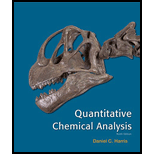
a)
Interpretation:
The absorbance detection limit of the sample has to be calculated.
Concept Introduction:-
Detection limit:-
The concentration of an analyte that produces a signal which is equal to three times the standard deviation of a signal from a blank.
The minimum detectable concentration ydl can be defined as,
signal detection limit ydl= yblank+ 3s
Where,
s = Standard deviation.
m = Slope of linear calibration curve.
a)
Answer to Problem 5.AE
The absorbance detection limit of the sample has to be calculated as 0.003112
Explanation of Solution
Given,
The low concentrations samples near the detection limit are.
0.0006,0.0012,0.0022,0.0005,0.0016,0.0008,0.00017,0.0010,0.0011
Mean reading of nine blanks are 0.001189
The calculated standard deviation of 9 samples is0.000644.
ydl= yblank+ 3s
ydl= 0.00118+ 3(0.00688)=0.003112
The absorbance detection limit of the sample has to be calculated as 0.003112.
b)
Interpretation:
The minimum detectable concentration of the sample has to be calculated.
Concept Introduction:-
Detection limit:-
The concentration of an analyte that produces a signal which is equal to three times the standard deviation of a signal from a blank.
minimum detectable concentration = 3sm
Where,
S = Standard deviation.
m = Slope of linear calibration curve.
b)
Answer to Problem 5.AE
The minimum detectable concentration of the sample has to be calculated as 8.6×10-8M
Explanation of Solution
Given,
The low concentrations samples near the detection limit are.
0.0006,0.0012,0.0022,0.0005,0.0016,0.0008,0.00017,0.0010,0.0011
Mean reading of nine blanks are 0.001189
The slope of the calibration curve is 2.24×104M−1
The calculated standard deviation of 9 samples is0.000644.
minimum detectable concentration = 3sm =3(0.000644)2.24×104 M-1=8.6×10-8 M
The minimum detectable concentration of the sample has to be calculated as 8.6×10-8M
c)
Interpretation:
The lower limit quantitation of the sample has to be calculated.
Concept Introduction:-
Detection limit:-
The concentration of an analyte that produces a signal which is equal to three times the standard deviation of a signal from a blank.
lower limit of quantitation = 10sm
Where,
S = Standard deviation.
m = Slope of linear calibration curve.
Lower limit of quantitation:-
In
lower limit of quantitation = 10sm
c)
Answer to Problem 5.AE
The lower limit of quantitation of the sample has to be calculated as 2.9×10-7M
Explanation of Solution
Given,
The low concentrations samples near the detection limit are.
0.0006,0.0012,0.0022,0.0005,0.0016,0.0008,0.00017,0.0010,0.0011
Mean reading of nine blanks are 0.001189
The slope of the calibration curve is 2.24×104M−1
The calculated standard deviation of 9 samples is0.000644.
lower limit of quantitation = 10sm =10(0.000644)2.24×104 M-1=2.9×10-7 M
The lower limit of quantitation of the sample has to be calculated as 2.9×10-7M
Want to see more full solutions like this?
Chapter 5 Solutions
Quantitative Chemical Analysis
- Calculate the pH and the pOH of each of the following solutions at 25 °C for which the substances ionize completely: (a) 0.000259 M HClO4arrow_forwardWhat is the pH of a 1.0 L buffer made with 0.300 mol of HF (Ka = 6.8 × 10⁻⁴) and 0.200 mol of NaF to which 0.160 mol of NaOH were added?arrow_forwardDetermine if the following salt is neutral, acidic or basic. If acidic or basic, write the appropriate equilibrium equation for the acid or base that exists when the salt is dissolved in aqueous solution. If neutral, simply write only NR. Be sure to include the proper phases for all species within the reaction. NaN₃arrow_forward
- A. Draw the structure of each of the following alcohols. Then draw and name the product you would expect to produce by the oxidation of each. a. 4-Methyl-2-heptanol b. 3,4-Dimethyl-1-pentanol c. 4-Ethyl-2-heptanol d. 5,7-Dichloro-3-heptanolarrow_forwardWhat is the pH of a 1.0 L buffer made with 0.300 mol of HF (Ka = 6.8 × 10⁻⁴) and 0.200 mol of NaF to which 0.160 mol of NaOH were added?arrow_forwardCan I please get help with this.arrow_forward
- Determine if the following salt is neutral, acidic or basic. If acidic or basic, write the appropriate equilibrium equation for the acid or base that exists when the salt is dissolved in aqueous solution. If neutral, simply write only NR. Be sure to include the proper phases for all species within the reaction. N₂H₅ClO₄arrow_forwardPlease help me with identifying these.arrow_forwardCan I please get help with this?arrow_forward
 ChemistryChemistryISBN:9781305957404Author:Steven S. Zumdahl, Susan A. Zumdahl, Donald J. DeCostePublisher:Cengage Learning
ChemistryChemistryISBN:9781305957404Author:Steven S. Zumdahl, Susan A. Zumdahl, Donald J. DeCostePublisher:Cengage Learning ChemistryChemistryISBN:9781259911156Author:Raymond Chang Dr., Jason Overby ProfessorPublisher:McGraw-Hill Education
ChemistryChemistryISBN:9781259911156Author:Raymond Chang Dr., Jason Overby ProfessorPublisher:McGraw-Hill Education Principles of Instrumental AnalysisChemistryISBN:9781305577213Author:Douglas A. Skoog, F. James Holler, Stanley R. CrouchPublisher:Cengage Learning
Principles of Instrumental AnalysisChemistryISBN:9781305577213Author:Douglas A. Skoog, F. James Holler, Stanley R. CrouchPublisher:Cengage Learning Organic ChemistryChemistryISBN:9780078021558Author:Janice Gorzynski Smith Dr.Publisher:McGraw-Hill Education
Organic ChemistryChemistryISBN:9780078021558Author:Janice Gorzynski Smith Dr.Publisher:McGraw-Hill Education Chemistry: Principles and ReactionsChemistryISBN:9781305079373Author:William L. Masterton, Cecile N. HurleyPublisher:Cengage Learning
Chemistry: Principles and ReactionsChemistryISBN:9781305079373Author:William L. Masterton, Cecile N. HurleyPublisher:Cengage Learning Elementary Principles of Chemical Processes, Bind...ChemistryISBN:9781118431221Author:Richard M. Felder, Ronald W. Rousseau, Lisa G. BullardPublisher:WILEY
Elementary Principles of Chemical Processes, Bind...ChemistryISBN:9781118431221Author:Richard M. Felder, Ronald W. Rousseau, Lisa G. BullardPublisher:WILEY





